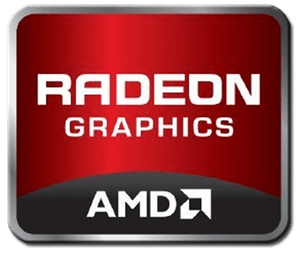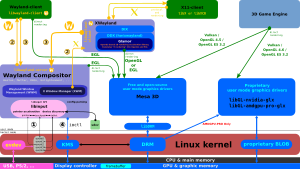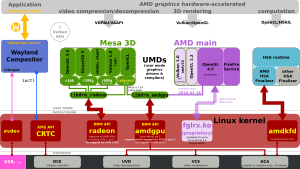Radeon facts for kids
| Release date | 1 April 2000 by ATI Technologies | ||||||||||||||||||||||||||||||||||||||||||||||||||||||||||||
|---|---|---|---|---|---|---|---|---|---|---|---|---|---|---|---|---|---|---|---|---|---|---|---|---|---|---|---|---|---|---|---|---|---|---|---|---|---|---|---|---|---|---|---|---|---|---|---|---|---|---|---|---|---|---|---|---|---|---|---|---|---|
| Models | 2000–02: Radeon 7000, 8000, 9000 series
|
||||||||||||||||||||||||||||||||||||||||||||||||||||||||||||
| Transistors |
|
||||||||||||||||||||||||||||||||||||||||||||||||||||||||||||
| History | |||||||||||||||||||||||||||||||||||||||||||||||||||||||||||||
| Predecessor | Rage | ||||||||||||||||||||||||||||||||||||||||||||||||||||||||||||
Radeon is a well-known brand of computer parts. It includes graphics processing units (GPUs), which are like the brain for your computer's display. It also makes random-access memory (RAM), and software for RAM disks and solid-state drives (SSDs). These products are made by Radeon Technologies Group, which is part of AMD. The Radeon brand first started in 2000 with a company called ATI Technologies. AMD bought ATI in 2006.
Contents
- Radeon Graphics: How Your Computer Sees the World
- Radeon Graphics Chip Generations
- Graphics Device Drivers
- Radeon Memory
- Radeon RAMDisk
- Radeon SSD
- See also
Radeon Graphics: How Your Computer Sees the World
Radeon Graphics cards are the next step after the older Rage line of graphics products. Over the years, Radeon has used different ways to design its graphics chips. These designs help your computer create the images you see on your screen.
ATI and AMD have also created many special technologies. For example:
- Eyefinity lets you use multiple computer screens at once.
- PowerPlay helps save power, especially in laptops.
- CrossFire allows you to use two or more graphics cards together for better performance.
- Some Radeon chips also include special parts like the Unified Video Decoder for playing videos smoothly.
The brand used to be called "ATI Radeon" until August 2010. Then, it changed to "AMD Radeon" to make AMD's name more widely known. So, cards up to the HD 5000 series are "ATI Radeon," while the HD 6000 series and newer are "AMD Radeon."
In 2015, AMD's graphics part became its own group called Radeon Technologies Group.
Who Makes Radeon Graphics Cards?
AMD designs the main Radeon graphics chips (GPUs). However, AMD doesn't usually sell the complete graphics cards directly to you. Instead, they sell their GPUs to other companies. These companies then build the full graphics cards and sell them to computer makers and stores.
Some of the companies that make Radeon-based graphics cards include:
Radeon Graphics Chip Generations
Graphics chips are updated over time, just like game consoles or phones. Each update is called a "generation." Early Radeon chips had numbers and letters, like "R100." Later ones were given special code names, like "Navi." If a chip was a big new design, its name started with "R" (like R300). Smaller updates often started with "RV" (like RV370).
Fixed-pipeline family TeraScale-family Graphics Core Next-family RDNA-family
| 2000 | Radeon R100 |
|---|---|
| 2001 | Radeon R200 |
| 2002 | Radeon R300 |
| 2003 | |
| 2004 | Radeon R400 |
| 2005 | Radeon R500 |
| 2006 | |
| 2007 | Radeon R600 |
| Radeon RV670 | |
| 2008 | Radeon R700 |
| 2009 | Evergreen |
| 2010 | Northern Islands |
| 2011 | |
| 2012 | Southern Islands |
| 2013 | Sea Islands |
| 2014 | |
| 2015 | Volcanic Islands |
| 2016 | Arctic Islands |
| 2017 | Vega |
| 2018 | |
| 2019 | Navi |
| 2020 | Navi 2X |
| 2021 | |
| 2022 | Navi 3X |
Early Radeon Designs (Fixed-pipeline family)
R100/RV200: The Beginning
The first Radeon chip, called R100, came out in 2000. It was the first graphics processor from ATI that fully supported DirectX 7. This meant it could handle graphics in a new and better way. The R100 also brought a new technology called HyperZ that helped it work faster.
The RV200, released in 2002, was a smaller, improved version of the R100. The Radeon 7500 was the main card from this time.
R200: More Advanced Graphics
ATI's second generation of Radeon chips, the R200, had a more complex way of drawing pixels. It was one of the first to use Microsoft's pixel shader 1.4. This allowed for more detailed and realistic graphics.
R300/R350: DirectX 9.0 Support
The R300 was a big step forward. Released in 2001, it was the first graphics chip to fully support Microsoft's DirectX 9.0. This allowed for even more realistic graphics in games and programs. It could also be programmed to create custom visual effects.
About a year later, the R350 improved on this design. It could run at higher speeds and access memory more efficiently. In 2004, new versions like the X300 and X600 were made for the new PCI Express computer connection.
R520: Better Lighting and Anti-Aliasing
The R520 series came out in October 2005. These cards supported DirectX 9.0c and Shader Model 3.0. They brought new features like floating-point rendering, which is important for realistic lighting effects (called HDR). They also improved anti-aliasing, which makes jagged edges in graphics look smoother.
TeraScale Family: Unified Shaders Arrive
R600: A New Way to Process Graphics
The R600 was ATI's first graphics chip to use a "unified shader model." This was a big change from older designs. It meant the chip could handle different types of graphics tasks more flexibly. Later versions of this design were made for laptops to save power.
R700: More Power and Speed
Based on the R600, the R700 architecture added many more "stream processors." These are like small engines that do the graphics calculations. It also improved power use and added support for faster GDDR5 memory. The HD 4850 and HD 4870 cards, released in 2008, were popular from this series.
Evergreen: DirectX 11 and 40nm Process
Launched in September 2009, the Evergreen series was a major update. All cards in this series were made using a smaller 40nm manufacturing process, which made them more efficient. They also had more stream cores and were ready for DirectX 11, a new version of Microsoft's graphics software that came out with Microsoft Windows 7.
Northern Islands: AMD Brand Takes Over
This was the first series to be sold only under the "AMD" brand. It used an improved 40nm design with updated shaders for better performance. Released in October 2010, cards like the 6850 and 6870 were part of this series. They also supported new ways to connect to displays, like HDMI 1.4a and DisplayPort 1.2, which helped with 3D output.
Graphics Core Next Family: Modern Graphics =
Southern Islands: Introducing GCN
The "Southern Islands" series was the first to use a brand new design called "Graphics Core Next" (GCN). This new design was a big change, focusing on making the chips better at computing tasks, not just drawing graphics. The higher-end cards used GCN, while some lower-end cards still used older designs. The Radeon HD 7790 was the first card in this series to use a newer version of GCN (GCN 2).
Sea Islands: Mostly Rebrands
The "Sea Islands" cards were mostly just renamed versions of the 7000 series for computer manufacturers. Only a few, like those with the "Oland" chip, were sold directly to people.
Volcanic Islands: More GCN Power
The "Volcanic Islands" GPUs came out with the AMD Radeon Rx 200 Series in late 2013. Most of these cards used the GCN design. The more powerful R9 290x/290 and R7 260X/260 used GCN 2.
Caribbean Islands: All GCN
The "Caribbean Islands" GPUs were part of the AMD Radeon Rx 300 Series, released in 2015. This was the first series where all the models used the GCN design, from older GCN versions to the newest GCN 3. This included powerful cards like the Fury X and Fury.
Arctic Islands: Polaris Chips
The "Arctic Islands" GPUs were first seen in the Radeon RX 400 Series in June 2016. These cards used new "Polaris" chips, which were based on the 4th generation of GCN (GCN 4). They were also made using a smaller 14nm process. The RX 500 Series, released in 2017, also used Polaris chips.
Vega: High-Performance Graphics
The Vega series brought even more powerful GCN designs, focusing on high performance for gaming and professional tasks.
RDNA Family: The Latest Generation
In May 2019, AMD announced a brand new graphics design called 'RDNA'. This new design replaced GCN. The first cards to use RDNA were the Radeon RX 5700-series, known by the code name 'Navi'. These cards used faster GDDR6 memory and supported PCI Express 4.0, which is a faster way for the graphics card to talk to the computer.
RDNA 2: Next-Gen Consoles and More
In March 2020, AMD announced RDNA 2, an improved version of the RDNA design. This architecture is used in the Xbox Series X and Series S and PlayStation 5 game consoles.
AMD showed off its new RDNA 2 graphics cards, the Radeon RX 6000 series, in October 2020. This lineup included the RX 6800, RX 6800 XT, and RX 6900 XT. These cards were released in late 2020. Later, other cards like the RX 6700, RX 6600, and RX 6500 series were also released.
Graphics Device Drivers
Graphics cards need special software called "drivers" to work correctly with your computer's operating system. These drivers help the graphics card understand what to do and how to display images.
AMD's Official Drivers: Radeon Software
On November 24, 2015, AMD released a new version of their graphics driver called Radeon Software Crimson Edition. This driver had a new look and feel, making it easier to use. It included tools for managing games and adjusting card settings.
Radeon Software is made for Microsoft Windows and Linux operating systems. Other operating systems are not officially supported by AMD for these drivers.
Radeon Software on Different Operating Systems
AMD's official Radeon Software is mainly for Windows and Linux. In the past, ATI (before AMD bought them) also made drivers for Mac OS 9 and macOS. Now, macOS drivers for Radeon cards are usually provided by Apple itself.
Free and Open-Source Radeon Drivers
Besides AMD's official drivers, there are also "free and open-source" drivers for Radeon cards. These drivers are developed by many people, including Linux developers, other programmers, and even some AMD employees. They are constantly being improved.
These open-source drivers are mostly developed for and used on Linux. They can support many features of Radeon cards, like using multiple monitors. Since they are open-source, they can also be adapted for other operating systems. For example, FreeBSD, MorphOS, AmigaOS 4, and Haiku all have some level of support for Radeon cards using these open-source drivers.
Radeon Memory
In August 2011, AMD started using the Radeon name for computer memory modules (RAM). These included different types of DDR3 SDRAM for entertainment, gaming, and business use. Later, they released Radeon RG2133 Gamer Series Memory and Radeon R9 2400 Gamer Series Memory.
Dataram Corporation is the company that makes this RAM for AMD.
Radeon RAMDisk
In 2012, AMD partnered with Dataram Corporation to create "Radeon RAMDisk" software. This software lets you use some of your computer's RAM as a super-fast temporary storage drive, like a RAM disk. This can make games load much faster.
There was a free version that supported up to 4GB of RAM disk space (or 6GB if you had certain AMD Radeon memory). A paid version allowed for much larger RAM disks.
Radeon SSD
AMD also entered the solid-state drive (SSD) market with Radeon-branded SSDs. The R7 Series SSDs, released in 2014, used parts from Toshiba and Indilinx. These SSDs were known for being very fast.
See also
 In Spanish: Radeon para niños
In Spanish: Radeon para niños
- AMD FirePro – A brand for professional graphics cards based on Radeon GPUs.
- AMD Radeon Pro – The newer name for professional graphics cards, replacing FirePro.
- AMD FireStream – A brand for special cards used for complex calculations (GPGPU).
- AMD FireMV – A brand for cards designed to power many monitors.




